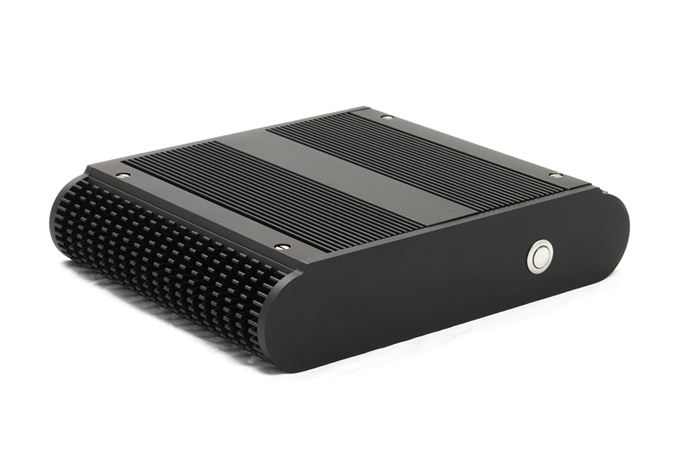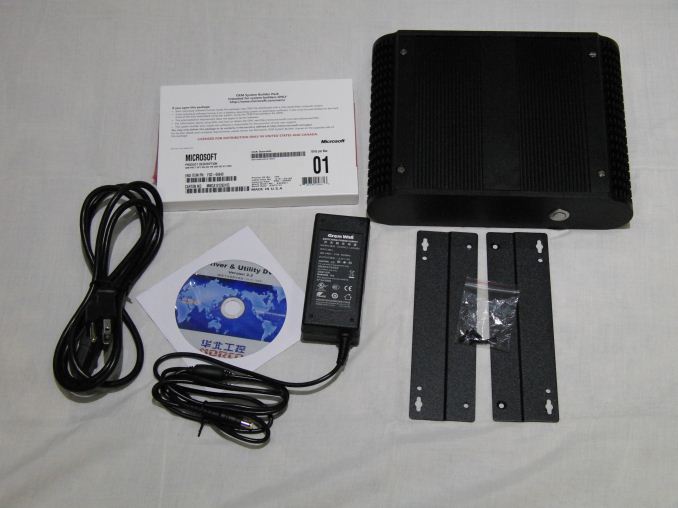HABEY BIS-6922 Fanless Ivy Bridge Industrial PC Review
by Ganesh T S on August 13, 2013 9:00 AM EST- Posted in
- Industrial PC
- Ivy Bridge
- Passive Cooling
- Habey

Introduction
Industrial PCs come with stringent requirements that are not satisfied by generic PCs. It is customary for builders to use active cooling in order to ensure that the components are in proper working order. Ventilation slots are also provided to keep airflow up. Chassis size is also not always a concern. However, these flexibilities are not always possible in industrial PCs. Operating environments for such systems usually call for passive cooling, dust resistance, rugged nature and minimal size (read, mini-ITX).
We reviewed the Aleutia Relia last year. Today, we are adding another fanless Ivy Bridge PC to the list, the Habey BIS-6922. The unit was launched late last year. Unlike units meant for the traditional PC market, embedded and industrial units are more focused on long term support and reliability rather than the latest and greatest that the silicon vendor has to offer. So, it is not surprising that Ivy Bridge-based industrial computers are seeing a strong presence in the market only now, after long-term validation by the manufacturers. The high level specifications of the BIS-6922 are available in the launch piece. In the table below, we have a quick overview of the configuration of the review unit sent by Habey.
| Habey BIS-6922 Industrial PC Specifications | |
| Processor |
Intel Ivy Bridge Core i7-3720QM (4 x 2.60 GHz (3.60 GHz Turbo), 22nm, 6MB L2, 45W) |
| Chipset | Intel QM77 |
| Memory | 2 x 4GB DDR3-1333 |
| Graphics |
Intel HD Graphics 4000 650 MHz / 1.25 GHz (Turbo) |
| Disk Drive(s) | 60 GB Intel SSD 330 |
| Networking | 2 x Gigabit Ethernet |
| Audio |
Microphone and headphone/speaker jacks Capable of 5.1/7.1 digital output with HD audio bitstreaming (HDMI) |
| Operating System |
Windows 7 Professional 64-bit (Retail unit has choice of OSes including barebones option) |
| Pricing (As configured) | ~$1500 (Varies depending on customization) |
| Full Specifications | BIS-6922 Specifications |
Our review unit came with the above internal configuration. In addition, we had the installation disk for a OEM copy of Windows 7 Professional x64, a 60 W DC power adapter, mounting plates with screws and a driver and utility CD. I wonder why companies bother with these optical discs when the product itself carries no optical drive. With Flash becoming more economical day-by-day, it might make better sense to bundle these in a USB stick instead of a CD or DVD.
The first section of the review will deal with the setup impressions and teardown of the system. We will take a close look at the thermal design. This is followed by results from our performance evaluation. The numbers will help up get an idea of the relative performance of the unit compared to other PCs with low power consumption. A separate section on thermal performance is also included.











63 Comments
View All Comments
airmantharp - Tuesday, August 13, 2013 - link
It's too hot? Only if you lock it away. But since it's small and it produces no noise, you could place it somewhere it might get airflow, unlike a larger system.But why would a music or movie editor use one of these? How is that representative at all? GigE isn't fast enough for that, there is no TB port, so what, USB3? Really?
I think you're perspective on this system is poor- this system is designed to be used outside of the living room, which the Mac Pro is not; and the Mac Pro is huge in comparison!
UpSpin - Wednesday, August 14, 2013 - link
My current computer is a MiniITX placed on my desk next to my display. I would place the habey PC on the same place, and there's just no airflow, except I mount a fan on top of it. I also don't think that Ganesh placed this computer inside a small box but ran it on his main desk.What person needs a quad core high end system? How is GigE not fast enough? Why should USB3 (5Gbit/s) not be fast enough? And what has all of this to do with TB? And how are Windows people able to do music or video right now? They also don't have TB! And they also can't stuff all hard discs in their case, but need some larger and more secure storage server somewhere else.
Why do you compare the Mac Pro with this one? I only mentioned it because of its design. The design of this habey is just poor and fails to cool the system. A design similar to the Mac Pro which makes use of a chimney effect would have been much better.
So this system is to be used outside of the living room, but according to you also not suited for work because it lacks TB and we might tax it too much. So we could use it for terminals which need a quad core CPU (I don't know a single use case), but therefore it's also not suited because it will get too hot because there won't be any air flow either.
I don't get it, where can we use such a thing?
Dentons - Wednesday, August 14, 2013 - link
You're right. There is no use-case for this system as configured. None at all.Either you need an i7 or you don't. If you need an i7, this product can't cool it adequately, so is a terrible choice.
ganeshts - Wednesday, August 14, 2013 - link
I am pretty sure Habey's intent was to provide enough CPU grunt for occasional bursts and not 24x7 loading.I am still waiting for someone to link me to a similar product (size / CPU perf.) with better thermal performance.
Dentons - Wednesday, August 14, 2013 - link
There may not be any similar product able to handle the heat created by a fully utilized i7. That doesn't excuse this product's failings. What it actually suggests is that Habey reached too high.It shouldn't be surprising that a fully utilized i7 needs active cooling.
UpSpin - Thursday, August 15, 2013 - link
I completely disagree. It's a quad core! If Habey wanted to provide a CPU for occasional bursts used in industrial environments, they would have used a high end dual-core! If one program needs some more processing power it easily gets it. But barely any program scales dynamically across multiple cores, except high end software which won't get used in a terminal but in production environments. And then, this software really taxes the system. You also don't need a quad core for multi-tasking, except you really tax the system (maybe 3 cores) and still want to continue to work with the computer on the fourth core. But again, this Habey system won't support this without exceeding several temperature limits.And maybe there are no comparable systems, because such a small case with such a poor 08/15 design just can't dissipate the required heat without active cooling?
Dentons - Wednesday, August 14, 2013 - link
This is a machine designed to function without fans. If it requires air flow in order to work properly, the design is a failure. This case was probably designed to run with far cooler chips, but since that wasn't tested with those, we just don't know if it works adequately with them.Yes, a lot of video production is done on Mac's, but certainly not all. Probably not even half. Windows does still hold nearly 90% of the desktop / laptop market.
You fail to address the really important question. What is the point of an i7 if it's power can't actually be used? Transcode some video and the temperature of the case will exceed many safety standards and the internal components will be heated to well beyond their rated temps?
That's acceptable?
fluxtatic - Saturday, August 17, 2013 - link
The new Mac Pro isn't passive, and how the hell are industrial users going to use something that looks like a trashcan?The Mac Pro is a an honest-to-god workstation with a Xeon (well, it's got a Xeon, at least). This is like comparing Little League to MLB.
crashtech - Thursday, August 22, 2013 - link
It's Furmark. I wonder how hot the thing would get in any conceivable real-world app. Probably under half those temps. The takeaway is it passed a torture test.whyso - Tuesday, August 13, 2013 - link
Looks like its throttling. I have a 3630qm which gets about 6.3-6.4 in cinebench R11.5. This 3720QM is getting significantly lower than that.